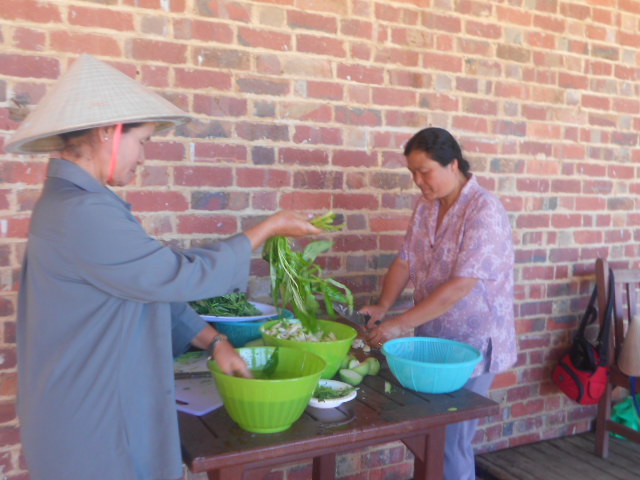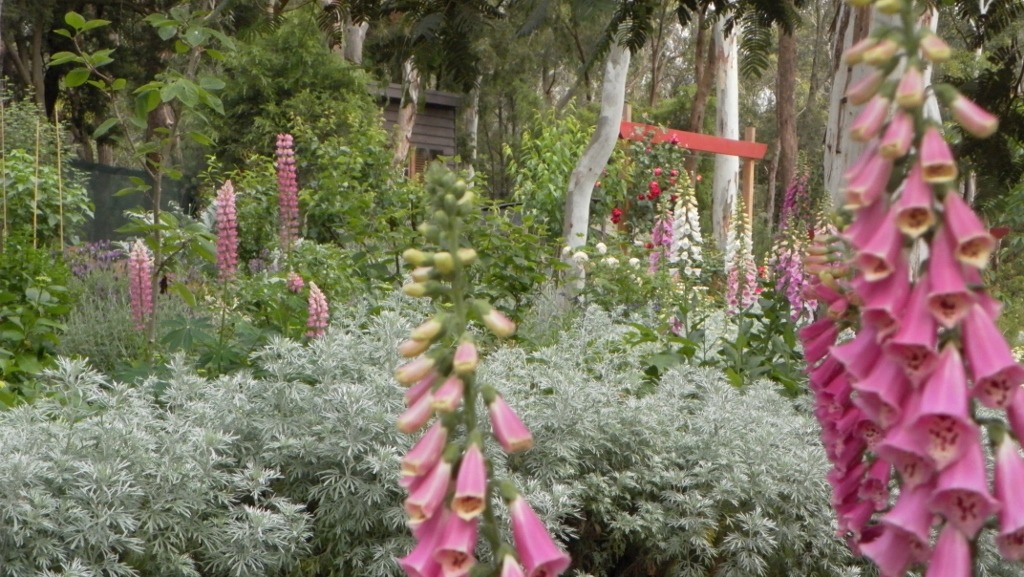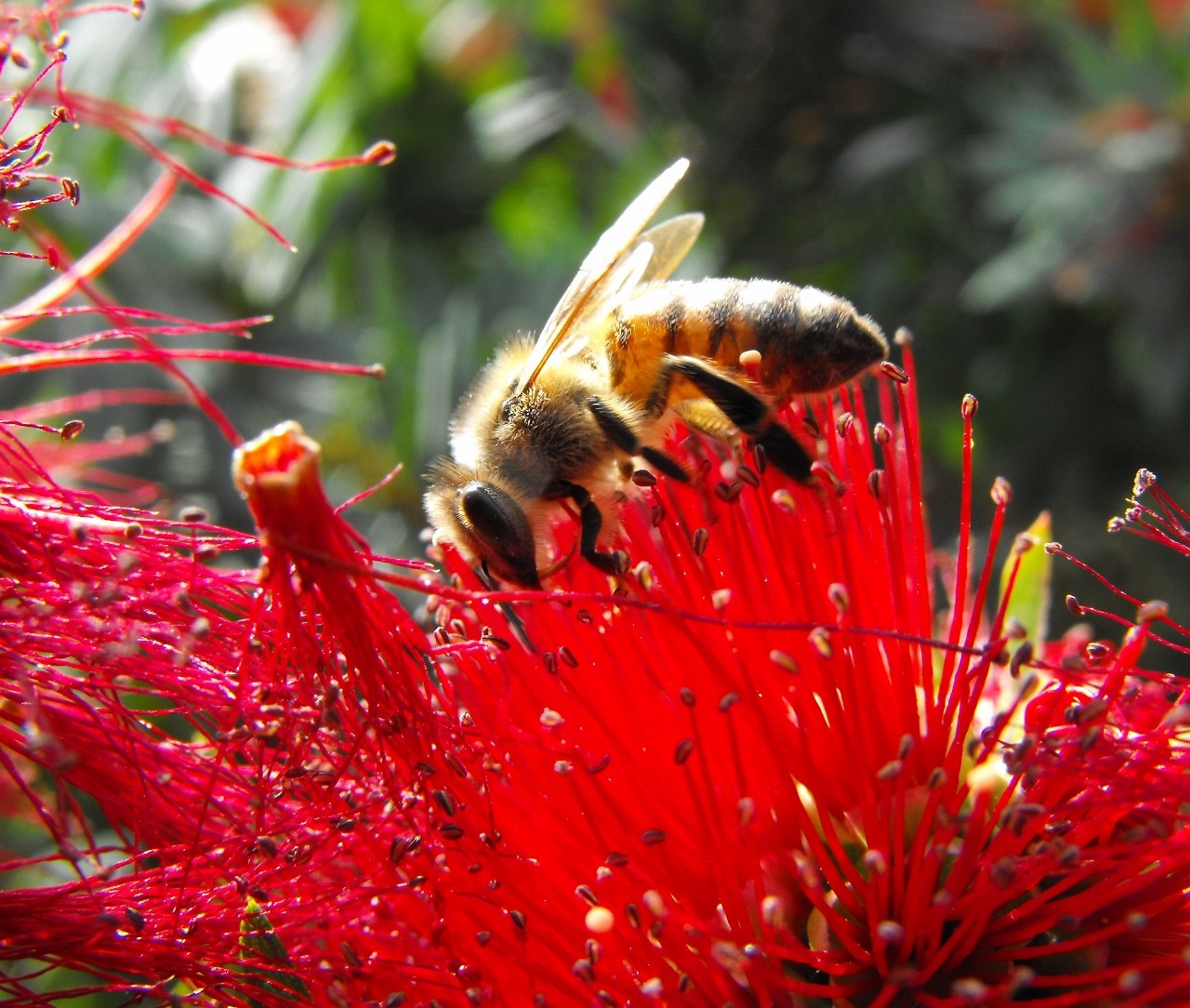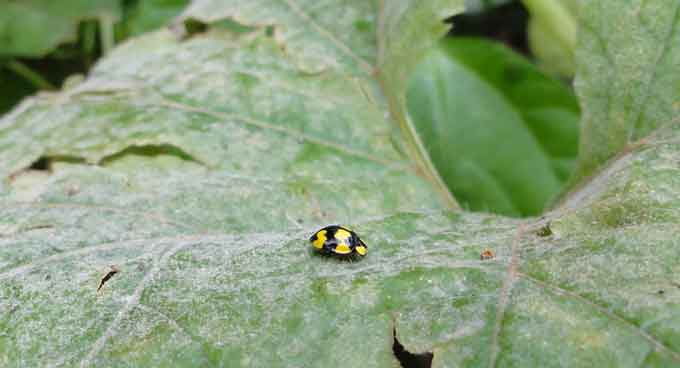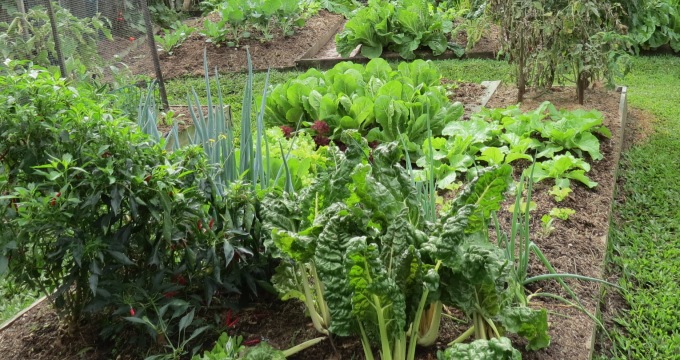Upcycled Containers for the Garden
If you like avoiding waste, being practical and saving money, then upcycling is for you. With a little imagination and a keen eye you can make interesting substitutes for pots in the garden. If you rent rather than own your garden, container growing is practical, avoids discussion with the landlord and allows you to take your garden with you when you move. Here are some examples, including those sent by our readers as part of a recycling photo competition earlier in 2013.
Plumbing items
We are probably all familiar with old baths used as planters and ponds, but think about pipes of all sorts such as those in the banner image above.
Household containers
Crockery and glassware have a variety of uses. They can be filled with water for birds if you make sure there is something they can grip with their feet. Porcelain containers can be given drainage holes if you drill carefully. Terracotta or ceramics can be used without drainage holes for plants like water chestnuts which need to be flooded when they mature.


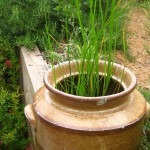
Kitchenware
Kettles, aluminium cans, mugs, pots, kettles, teapots and plastic or cardboard drink bottles have a variety of uses including mini-greenhouses, planters and plant guards. Just remember drainage holes for planters.
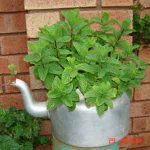
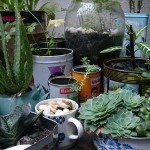
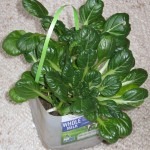
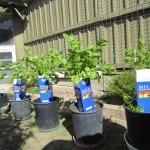
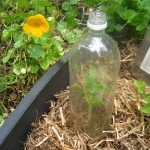


 Polystyrene fruit boxes and toilet roll tubes
Polystyrene fruit boxes and toilet roll tubes
If the holes in the base are covered with something like shade cloth to hold soil in place they make good planters. They can also be easily converted into wicking beds by lining with strong plastic, adding scoria, a layer of shade cloth and then soil. The cardboard from toilet rolls make convenient biodegradable pots for seedlings.
Vehicle parts
Surprisingly trucks and cars provide some interesting material. Springs can hold smaller pots, wheel rims convert into pots and hub cabs create an interesting support for climbers.
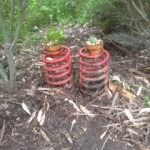
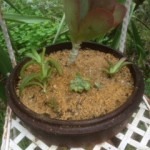

Garden gear
Wheelbarrows, watering cans and buckets which have developed rust or holes and old garden boots deserve upcycling too.

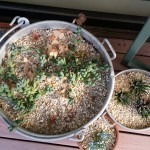
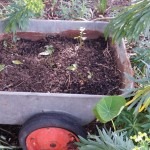
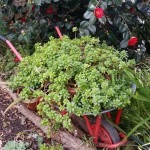
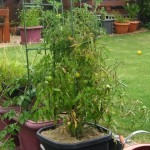
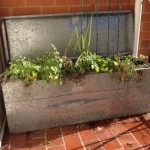
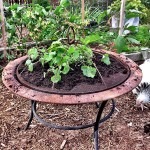 Other ideas
Other ideas
Other items make good planters too. Some examples are a fire pit, an old toolbox and plastic bins that had been used in local council recycling collections.
Just use your imagination!
Photo credits (numbered from top, left to right):
1, 2, 3, 7,: Ferelise Bonollo
4, 9, 15, 16, 22: Sharron Pfueller
5: Kelly Bennett
6: Sarah Rickard
8: Patricia Jarvie
10: Tahnia Trusler
11: Christine Neville
12: Dianne Palmer
13, 14: Judy Margolis
17, 18, 19: Tine Grimston
20: Catherine Stephenson
21: Vanessa Hagon
Guerilla Gardening with a Difference
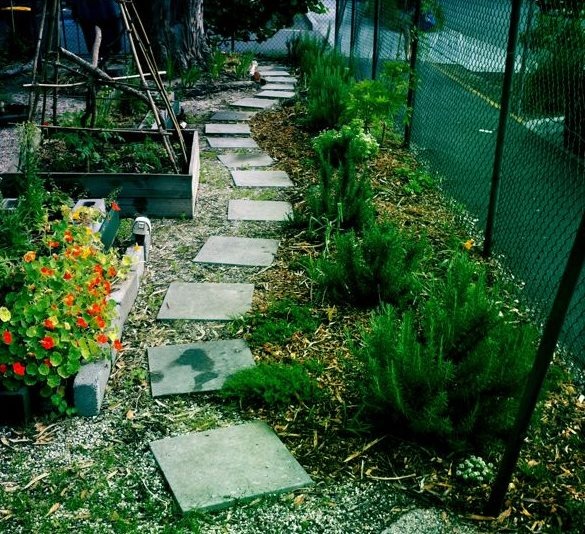 The movement called “guerrilla gardening” has taken off around the world. It is usually gardening on an unused piece of public land to produce food or to add some beauty to a barren area. Frequently carried out at night to avoid detection, it has sometimes been done as a protest against land misuse or neglect. We tell here a story of turning a piece of private land into a vibrant, productive garden with permission of the owner.Read more
The movement called “guerrilla gardening” has taken off around the world. It is usually gardening on an unused piece of public land to produce food or to add some beauty to a barren area. Frequently carried out at night to avoid detection, it has sometimes been done as a protest against land misuse or neglect. We tell here a story of turning a piece of private land into a vibrant, productive garden with permission of the owner.Read more
Garden Edging from Recycled Material
Not all of us have half a metre of topsoil in our backyards – unfortunately. So to get a decent depth for plants, especially veggies, to grow, we are confronted with the need to create raised beds. And if there is lawn next to the garden beds we usually want some sort of barrier to slow grass invasion. Edging materials can be expensive, so why not repurpose “rubbish” from elsewhere? It saves money and helps the planet too.
In our recent competition for photos of recycling, resourceful SGA supporters sent us great ideas for how to do this. Here are some of them.
Ferelise and Alan Bonollo have used second hand roof decking bolted to star picket pieces to raise sides of 10 vegetable beds about 7 metres long.
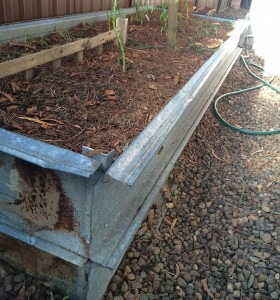
 A similar approach has been taken by Greg Thomson who has constructed raised garden beds from long lengths of metal from a friend’s house when she had her roof replaced. But the uprights in this case were aluminium angle corners salvaged from an air
A similar approach has been taken by Greg Thomson who has constructed raised garden beds from long lengths of metal from a friend’s house when she had her roof replaced. But the uprights in this case were aluminium angle corners salvaged from an air 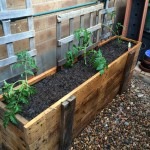 conditioner contractor on a building site. He has also used salvaged poles and branch material just laid on the ground and constructed a sturdy bed from timber found elsewhere.
conditioner contractor on a building site. He has also used salvaged poles and branch material just laid on the ground and constructed a sturdy bed from timber found elsewhere.
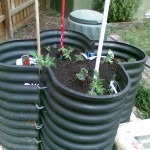
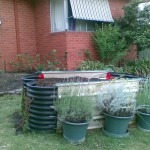 Many interesting items appear on the street for Council collection. Chris Reischel writes “Many of these 'old' corrugated compost bins seemed to be appearing on the scrap heap of people’s front nature strips, being thrown out as no longer useful. I knocked on doors and asked politely for them, collected them over a few months, strapped them together with cord, in one case added two strips of old colour bond fencing and created the cheapest easiest elevated garden beds around. Vegetables and rhubarb have grown fabulously".
Many interesting items appear on the street for Council collection. Chris Reischel writes “Many of these 'old' corrugated compost bins seemed to be appearing on the scrap heap of people’s front nature strips, being thrown out as no longer useful. I knocked on doors and asked politely for them, collected them over a few months, strapped them together with cord, in one case added two strips of old colour bond fencing and created the cheapest easiest elevated garden beds around. Vegetables and rhubarb have grown fabulously".
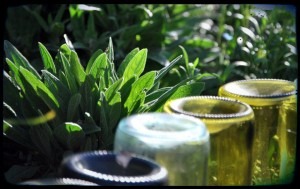
An innovative and unusual edging comes from Tahnia Trusler. She says “I have collected any glass bottles I could. Wine, olive oil, soft drinks, anything that comes in glass. It’s great when friends have a big party then I can raid their recycling bins and get lots of edging done in one go. It works really well because I can then build my garden beds up above the grass line.”
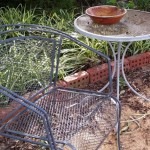
And, of course, old house bricks which always seem to turn up in backyards are extremely useful – even those with the holes as Tine Grimston has found.
Recycling in the Garden for Art or Function
Our recycling photo competition has produced an inspiring collection of ideas for giving old materials a second life in the garden! For some entrants, foraging local hard rubbish collections has become a very productive obsession. Several entrants have concentrated on creating works of art for both indoors and outdoors. Others have seen the potential of discarded materials to build structures for the garden and others have found another use for household items without needing to reconstruct them.
Making a decision about an absolute prize winner was impossible because of the fabulous creativity of all our entrants. So we have chosen winners in three categories i.e. art, constructions and repurposing. Even then, it was not easy to separate these categories from each other, so there was a tiny bit of overlap in some cases. So congratulations to all entrants and especially to the winners!
Art
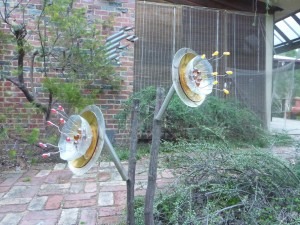 The winning entry for artistic creation goes to Carolyn Noel for some amazing flowers made from old dishes. At left, some enliven a dead tree. At right, are some "planted" in
The winning entry for artistic creation goes to Carolyn Noel for some amazing flowers made from old dishes. At left, some enliven a dead tree. At right, are some "planted" in 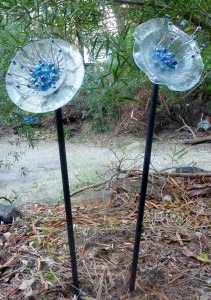 the ground.
the ground.
What a joy it must be to roam the garden in winter when these glass creations are happily blooming! Carolyn sent us many examples of her work saying “For many years I have been passionate about using what I have around the house and other people’s rubbish to improve my environment. I have recently retired from my work as a creative arts therapist and now spend much of my time in my shed making more adventurous works from roadside rubbish.” She hopes that our “readers are inspired to see rubbish in a whole new light”.
There were many beautiful pieces of work submitted to us by Carolyn and others, so we will feature a range of those in other web posts later in the year.
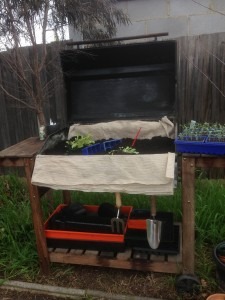 Repurposing
Repurposing
The most interesting repurposing endeavor was turning the barbie into a potting bench. It is almost as though this style of BBQ was designed for exactly that purpose in the first place. Congratulations to Kelly Wooster!
Construction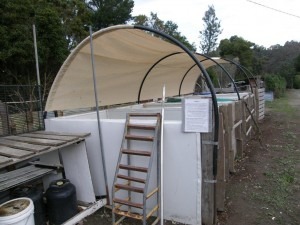
The prize for construction goes to Deborah Cantrill and Quentin Jones of Nirvana Organic Produce who have turned a freezer and cold room from a supermarket refit into several separate significant items. Along with panels from the walls there were racks and sliding Perspex lids.
The freezer panels were used for the walls of a series of 5 compost bays. Their inbuilt insulation keeps the compost warm and moist. The other materials used for this construction included used polypipe and timber from old pallets cut into thirds for the 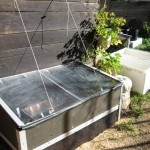 front removable panels.
front removable panels.
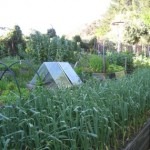 Covers for cold frames and a mini-glass house were created from the sliding lids.
Covers for cold frames and a mini-glass house were created from the sliding lids.
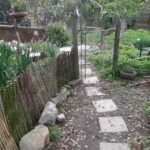 Wire racks were transformed to become plant protectors in the orchard, various barricades in the poultry pens, a sprouting bench for the chook yard, potting benches for the veggie garden, a tunnel house and, as in the picture at right, gates.
Wire racks were transformed to become plant protectors in the orchard, various barricades in the poultry pens, a sprouting bench for the chook yard, potting benches for the veggie garden, a tunnel house and, as in the picture at right, gates.
A big "thank you" to all the other avid recyclers for sending us their innovative work!
More photos of recycling in the garden will be featured in other web posts later on and also on our Facebook page.
Cities, Climate Change and Gardening
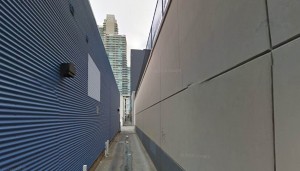 Rachel Reef writes: Have you ever noticed that somehow, the temperature seems to be lower on the outskirts and in the countryside? Yeah, so have I. But when you think of it, it absolutely makes sense with all that concrete downtown. Although the thought of more balmy summer days doesn’t seem like such a bad thing (hello, beach!), the decreasing amount of greenery in our cities means that city microclimates are forming and the heat rise could be affecting our health and bank balances - as well as our planet.
Rachel Reef writes: Have you ever noticed that somehow, the temperature seems to be lower on the outskirts and in the countryside? Yeah, so have I. But when you think of it, it absolutely makes sense with all that concrete downtown. Although the thought of more balmy summer days doesn’t seem like such a bad thing (hello, beach!), the decreasing amount of greenery in our cities means that city microclimates are forming and the heat rise could be affecting our health and bank balances - as well as our planet.
Cities are getting bigger, more polluted and less green, while climate change is becoming increasingly unavoidable. As more and more people are choosing the city-living lifestyle, what does this mean for our dear planet Earth?
The Urban Heat Island Effect
No, our cities aren’t going to turn into tropical islands (unfortunately)! Australian scientists have been conducting a study into the causes of the ‘urban heat island effect’. Essentially, in areas where there is less shade and more buildings (generally the CBD), heat gets trapped and temperatures can be several degrees higher than in the suburbs.
The cause of this is a combination of factors, including lack of vegetation, increased energy use (which emits heat) and the materials used in buildings.
Although this heat increase may not necessarily be felt by everyone, it does impact various areas of our lives. Professor Steffen Lehmann from the University of South Australia who is leading the research - titled The Urban Microclimates Research Project1 - has said that just a one degree drop in city temperatures means a decrease of 5 per cent in energy costs. For businesses and government, in particular, this could mean massive savings - but it would also benefit individuals living in the CBD (no one ever said no to lower energy bills!).
He also says that just a 10 per cent increase in CBD vegetation could help temperatures drop by up to 3°C.
Aside from the impact that increased green areas could have on our planet, it can also improve our mental health. A recent study2 assessed the mental impact of moving from less green areas to more green areas. It found significant evidence to suggest that those that moved to greener areas had much better mental health than before the move. And we don’t need studies to tell us this either - everyone feels more relaxed after a stroll through the park!
A lack of trees also increases the concentration of pollution in the air. Trees feed on carbon dioxide, and in turn they produce the oxygen that we need to live. To us, excess carbon dioxide is poisonous, so the more trees the less of it there is in the atmosphere. Trees also absorb a range of other poisonous gases, making the air healthier for us to breathe.
In fact, just one acre of trees absorbs as much carbon dioxide over a year as a person produces while driving a car over 26,000 miles/41,843 km!
What Part Can We Play?
Did you know that in Havana, Cuba, due to the shortage of fuel and fertilisers, residents were forced to start growing wherever possible, whatever possible? According to FAO, “Havana production in 2012 included 63,000 tonnes of vegetables, 2, 000 tonnes of fruit, 10,000 tonnes of roots and tubers, 10.5 million litres of cow, buffalo and goat milk and 1,700 tonnes of meat.” This means that, not only do they not have a problem with global heating, but they also eat healthy local produce.
In Milan, the Bosco Verticale3 project is just about to be finished. It consists of two residential buildings (more like skyscrapers) with trees planted on every balcony.
Furthermore, urban gardens are not that uncommon any more, and guerilla gardening is counting more and more members each day.
Of course, numerous cities around the world have plans to increase vegetation in urban areas, but residents don’t need to sit around and wait for possibly decades to achieve the benefits that a greener lifestyle can bring. By utilising the space that you have, you can play your small part in slowing down climate change, minimising air pollution and improving your own mental health, and much more.
Not all of us can take part in such outstanding projects or actions. Not all of us have huge gardens, nor is every city’s government so benevolent. So we should use whatever is within our reach.
What are our options? For example, if everyone in a city set up a balcony garden, it wouldn’t take long before a huge increase in vegetation would occur. Not only will you be taking a proactive approach to helping the environment, but studies have shown that gardening can promote mental health through relaxation and satisfaction. If you live in an apartment make your balcony garden work for you by planting herbs and other easy-to-grow vegetables that you can use in your everyday cooking.
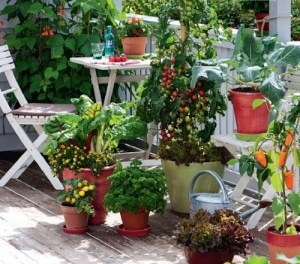 When it comes to what to grow, of course, flowers and shrubs take the throne. However, it does not stop there. Many people have started growing fruit and vegetables on their balconies. These primarily include small plants, and those that do not develop deep roots. Some of those are strawberries, blackberries, tomatoes, various peppers, cucumbers, courgettes, lemons, oranges, fruit salad trees, lettuce, herbs - the list is long and diverse.
When it comes to what to grow, of course, flowers and shrubs take the throne. However, it does not stop there. Many people have started growing fruit and vegetables on their balconies. These primarily include small plants, and those that do not develop deep roots. Some of those are strawberries, blackberries, tomatoes, various peppers, cucumbers, courgettes, lemons, oranges, fruit salad trees, lettuce, herbs - the list is long and diverse.
 Some balconies even can support trees!
Some balconies even can support trees!
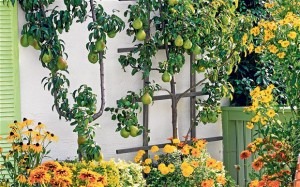
But, if you don’t have a balcony or outdoor area, don’t fret - there are still ways to help. Simply cutting down your energy usage and ensuring you have quality home insulation (such as double glazed windows) will minimise the amount of heat you are releasing.
City living doesn’t need to mean giving up a green lifestyle - get creative and welcome some plants into your life!
References
1. The Urban Microlimates Research Project. http://blog.lowcarbonlivingcrc.com.au/2013/tackling-urban-heat/
2. Alcock I1, White MP, Wheeler BW, Fleming LE, Depledge MH. Longitudinal effects on mental health of moving to greener and less green urban areas. Environ Sci Technol. 2014 Jan 21;48(2):1247-55.
3. http://www.stefanoboeriarchitetti.net/en/portfolios/bosco-verticale/
Rachel Reef has long been exploring ways of helping the environment in our ever growing cities. Recently she has been involved in raising awareness of the importance of planting wherever possible. In her free time, she enjoys watching her flowers bloom and walking her dog on the beach.
Rainwater Use – Some Updates
Water is one of the most valuable commodities. During drought, water supply is at high risk especially in areas that rely heavily on grazing and agriculture and use water for gardens. Yet, despite weather-related risks, water continues to receive little serious regard, except when water restrictions are implemented.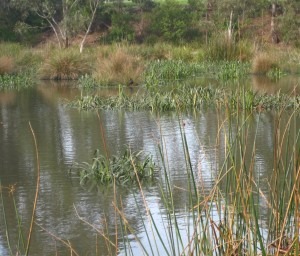
Data from the Australian Bureau of Statistics provides some interesting insights. In 2007-2008, 89% of Australians thought that water shortages were a concern but their most recent figure in 2011-2012 showed a decline to 64% 1.
Mains water continues to be the most common source of water in Australian households with 93% using it as their primary source in March 2013. This shrinking concern about water, combined with a growing population and weather irregularity that results in decreased rainfall, will continue to be reasons for water shortages in many years to come, unless everyone starts taking steps to adapt to the impacts of climate change.
 In 2013, 51% of the 7.3 million Australian households that had a garden used mains water as their primary source for gardening. But the proportion of households that have been taking steps to reduce water use in the garden has decreased from 71% in 2007, to 62% in 2010 and 54% in 20132.
In 2013, 51% of the 7.3 million Australian households that had a garden used mains water as their primary source for gardening. But the proportion of households that have been taking steps to reduce water use in the garden has decreased from 71% in 2007, to 62% in 2010 and 54% in 20132.
Enter the rainwater tank
Despite the fact that rainwater is not generally suitable for drinking and cooking (unless filtered and treated properly), it provides a valuable resource to households and helps sustain biodiversity in the garden. The use of rainwater tanks in Australian households living in a dwelling suitable for a tank has increased from 26% in 2007, 32% in 2010 to 34% in 2013 2 This trend may be result of government rebate schemes, water restrictions, regulations and pricing.
Many companies have started building businesses around the use of water tanks and a partnership between government and these companies was successfully established to expand rebate programs under the National Rainwater and Grey Water Initiative. This subsidizes allocation of water tanks in certain areas where water supply augmentation is indispensable.
Benefits of rainwater in gardens
Not only can rainwater use in gardens reduce demand on mains systems, it has some a range of benefits, some of which are little-known.
Nitrogen
It might be a surprise to many of use, but rain water contains some nitrogen. Two types of nitrogen are formed during rain, ammonia – an atmospheric gas that dissolves in rainwater - and nitrate which is produced by the reaction of water and atmospheric nitrogen by lightning during storms3. It can also be collected from particles in the air caused by various industrial processes. Rainwater may contain more nitrogen than mains water due to its absorption by soil as water percolates through catchment areas into dams4.
No chlorine
Chlorine does not exist in nature in elemental form but is combined with other chemicals and is extracted through the process of electrolysis. Rainwater does NOT contain chlorine. While it is helpful in treating water used for drinking, it can kill microorganisms beneficial to plants.
Since chlorine can dissolve in water and is present in bleach, grey water from washing machines which may contain chlorine bleach should not be used for irrigation. Excessive chlorine can disrupt the ability of plants to extract nutrients and, therefore, growth. When it accumulates in leaf tissue it causes a scorched or burnt appearance, smaller leaf size and early dropping5.
No Salt
Water from bores and wells, and in some areas, reticulated water supplies can contain salt. Rainwater does NOT contain salt. Evidence of a high salt content can easily be identified if plants are growing in pots by checking for any crusts of white and tan pigments. In many cases, salt-stressed plants may lose their colour and appear wilted. Salt effects on vegetation vary depending on the species:
Highly salt sensitive plants 6
Fruit: persimmon, passionfruit, strawberry, raspberry, avocado, loquat, almond, stone fruit, citrus fruit, apples, pears.
Vegetables: green beans, parsnips, celery, radish, squash, peas, onion, carrot.
Ornamentals: primula, gardenia, star jasmine, begonia, rose, azalea, camellia, ivy, magnolia, fuschia.
Slightly less sensitive plants
Fruit: mulberry, grape.
Vegetables: cucumber, capsicum, lettuce, sweet corn, rockmelon, potatoes, cauliflower, cabbage, watermelon, broccoli, pumpkin, tomato.
Ornamentals: hibiscus, geranium, gladiolus, bauhinia, zinnia, aster, poinsetta, lantana, Thuja orientalis, hop bush (Dodenea attenuata), banana (Musa spp), emu bush (Podocarpus), Juniperus chinensis, bottle brush (Callistemon 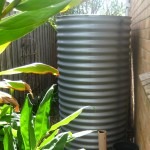 viminalis).
viminalis).
Moderately salt tolerant plants
Fruit: olive, fig, pomegranate.
Vegetables: spinach, asparagus, kale, garden beets.
(Other plant variations can be found in Department of Agriculture and Food, WA website6).
Tank storage mitigates flooding and erosion
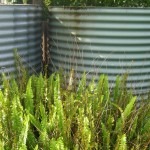 In many cities, increased areas of hard surfaces reduce soil capacity to take up water. This results in excessive runoff during heavy rainfall events which overloads stormwater systems causing both flooding and erosion. Storing some of this water in tanks can ameliorate some of these effects.
In many cities, increased areas of hard surfaces reduce soil capacity to take up water. This results in excessive runoff during heavy rainfall events which overloads stormwater systems causing both flooding and erosion. Storing some of this water in tanks can ameliorate some of these effects.
Cost benefits
 Once water tanks, large or small, are installed your water costs will be reduced. Who could resist that?
Once water tanks, large or small, are installed your water costs will be reduced. Who could resist that?
For more details about rainwater tanks and rainwater harvesting systems, see http://www.rainwatertanksdirect.com.au
References
1. Environmental views and behaviour, 2011-12
2. Environmental Issues: Water use and Conservation, Mar 2013
3. Highlights of Agricultural Research http://www.aaes.auburn.edu/comm/pubs/highlightsonline/spring99/nitrogen.html
4. http://www.newton.dep.anl.gov/askasci/env99/env99429.htm
5. University of Maryland, HGIC Lanscape Problem solver. http://plantdiagnostics.umd.edu/level3.cfm?causeID=1171
6. Department of Agriculture WA https://www.agric.wa.gov.au/water-quality-home-gardens?page=0%2C3
The author Sam Carslaw lives and works in Sydney and writes purely for fun. Passionate about serious subjects including sustainability and environmentalism, this hobbyist hopes only to add interest and personal insight to the wealth of the world wide web.
Photographs: SGA and Sam Carslaw
Minimising water use on lawns and turf
For the most sustainable lawn, SGA prefers Autralian native grasses rather than varieties that can become invasive. However, we recognise that many people really want the appearance and growth properties of grasses like Kikuyu or Buffalo. So Charlie Muscat tells us below which varieties of turf are more sustainable in terms of water use and how to care for them. To minimise unwanted spread, please remember to mow them before they set seed, to clip runners before they enter garden beds and to dispose of these so they cannot take root elsewhere.
Charlie writes:
Watering effectively is a crucial element of any lawn maintenance program. With the right choice of lawn, preparation and knowledge, however, you can keep watering to a minimum, saving time and money. How often your lawn needs water depends on lawn variety, soil type and its moisture retention, local climate, as well as water access and cost.
Lawn Variety
Low rainfall and the rising price of water in many Australian cities can affect people’s decision to install a lawn at all. The good news is that many lawn varieties today are drought-tolerant. Read more
Gardening for the Senses
“All the world's problems can be solved in a garden” Geoff Lawton, permaculturalist.
A few months back, we posted an article on how an aspect of sustainability – health – can be improved through gardening. It can make us healthier by promoting physical health, mental health through relaxation and satisfaction, and better nutrition. The scientific evidence clearly shows that gardening can indeed feed the body, mind and spirit!
Given that gardening can offer all this, let’s look at the practical aspect - what we can do at home, in our own gardens, to realise these health benefits.
We gain many health benefits just by simply gardening, but we can ‘garden intentionally’ to create a richer experience both when we work in our garden, and when we just sit back and appreciate it (1).
There are many ways to build a garden that will nourish every aspect of our being, and what follows is one such way. Here are some simple steps to enhance your garden so that it appeals to all your senses!
A Garden for All the Senses
To really appeal to all our senses, we can build a ‘sensory garden’. Such a garden can improve the education and social interactions of children with disabilities (2). This is a garden brimming with colours, scents, textures and shapes, designed with the purpose to engage as many of our senses as possible.
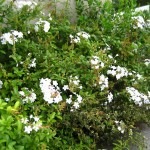 We have many choices here, flowers and coloured foliage can supply a kaleidoscope of colours to feast our eyes on. Cool colours, such as blue, purple, and white tend to be calming, soothing, and promote tranquillity, whereas warm colours such as red, orange, and yellow are stimulating and promote activity. Herbs have interesting flowers too
We have many choices here, flowers and coloured foliage can supply a kaleidoscope of colours to feast our eyes on. Cool colours, such as blue, purple, and white tend to be calming, soothing, and promote tranquillity, whereas warm colours such as red, orange, and yellow are stimulating and promote activity. Herbs have interesting flowers too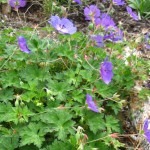 , as well as their main feature, scent! Many can be used for making fragrant teas.
, as well as their main feature, scent! Many can be used for making fragrant teas.
Culinary herbs have rich aromatic oils which provide a wonderful scent in the garden and taste in the kitchen. Medicinal herbs come in every shape, size and colour and can be used for maintaining our health as well as providing a stunning display in the garden.
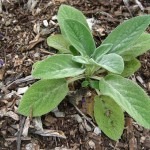 Tactile plants appeal to our sense of touch. Smooth, soft, silky leaves almost compel you to touch them! Springy groundcovers and succulent leaves add tactile interest to a garden, as do a few spiky plants. Choose plants that are resilient enough to be handled often.
Tactile plants appeal to our sense of touch. Smooth, soft, silky leaves almost compel you to touch them! Springy groundcovers and succulent leaves add tactile interest to a garden, as do a few spiky plants. Choose plants that are resilient enough to be handled often.
Aromatic plants such as the mints and scented pelargonium are the scent mimics of the plant world, they can they copy such a wide range of scents found in the plant kingdom, and then some. Beyond the usual 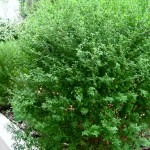 common mint smell, peppermint and spearmint, there are mints that smell like apples, basil, chocolate, menthol and even Eau de Cologne. Not to be outdone, there are scented pelargoniums that smell like lemon, lime, orange, rose, citronella, peppermint, coconut, nutmeg, bubblegum and even ‘Old Spice’ aftershave... Many Australian native plants also have delightful scents. We are familiar with lemon-scented eucalypts but Prostanthera sieberi (pictured at right) waft a wonderful mint scent in warm weather or when touched.
common mint smell, peppermint and spearmint, there are mints that smell like apples, basil, chocolate, menthol and even Eau de Cologne. Not to be outdone, there are scented pelargoniums that smell like lemon, lime, orange, rose, citronella, peppermint, coconut, nutmeg, bubblegum and even ‘Old Spice’ aftershave... Many Australian native plants also have delightful scents. We are familiar with lemon-scented eucalypts but Prostanthera sieberi (pictured at right) waft a wonderful mint scent in warm weather or when touched.
 Sound is an important element, and the rustling of leaves and grasses can be quite soothing, as can be the flow of water from a fountain or water feature. Living things enliven a garden, and habitat gardening will bring in lots of life to animate the space. Use trees and plants which attract birds and bees into the garden. Add birdbaths and perches.
Sound is an important element, and the rustling of leaves and grasses can be quite soothing, as can be the flow of water from a fountain or water feature. Living things enliven a garden, and habitat gardening will bring in lots of life to animate the space. Use trees and plants which attract birds and bees into the garden. Add birdbaths and perches.
Remember to create a shady, quiet spot where you can sit down, relax and enjoy the garden!
By creating a space where we can reconnect with nature, we can provide ourselves the means to heal our mind, body and spirit, and a means heal the planet also. When we grow gardens, we grow life, which we care for, nurture and partake in.
References
1. M.M. Tyson. 1998. The Healing Landscape. McGraw Hill.
2. H. Hussein. 2010. Using the sensory garden as a tool to enhance the educational development and social interaction of children with special needs. Support for Learning 25 (1) 25-31.
Photo credits: Salvia: Phillip Eliades. Water lily: Angelo Eliades. Waratah, Geranium, Prostanthera, Stachys byzantina: Sharron Pfueller
What are the possibilities when modern communities grow more of their own food?
 Earlier in the year around 70 SGA supporters made the trek out to Brunswick to participate in the first in a series of World Café style events as part of SGA’s ongoing commitment to inspire, empower and connect communities to garden sustainably. A World Café event typically revolves around a single question that participants discuss with each other over a series of rounds. The question for the evening was “what are the possibilities when modern communities grow more of their own food?” At the end of the evening our panelists Pete Huff (Yarra City Council), Natasha Kuperman (My Home Harvest) and Cam Walker (Friends of the Earth) answered questions from our participants.Read more
Earlier in the year around 70 SGA supporters made the trek out to Brunswick to participate in the first in a series of World Café style events as part of SGA’s ongoing commitment to inspire, empower and connect communities to garden sustainably. A World Café event typically revolves around a single question that participants discuss with each other over a series of rounds. The question for the evening was “what are the possibilities when modern communities grow more of their own food?” At the end of the evening our panelists Pete Huff (Yarra City Council), Natasha Kuperman (My Home Harvest) and Cam Walker (Friends of the Earth) answered questions from our participants.Read more
Wellbeing Gardening – Gardening for the Body, Mind & Spirit
“I go to nature to be soothed and healed, and to have my senses put in tune once more” - John Burroughs (1837-1921), American naturalist and writer.
Gardening is a very healthy hobby, on so many levels. It’s not just about filling our tummy either, there’s a lot more to be had from a well designed garden than a tasty meal!
Studies show that gardening promotes physical health, mental health through relaxation and satisfaction, and better nutrition [Source: Wakefield].
Gardening can indeed feed the body, mind and spirit! And that's important for a sustainable society.
Gardening for the Body
The primary reason why people decided thousands of years ago to grow plants was to sustain their bodies. This is still a very valid reason today, but there are many other reasons why gardening is beneficial to our physical health.
Some of these are:
- Stress relief
- Exercise
- Brain health
- Nutrition
- Healing
- Immunity
Stress relief - A study in the Netherlands indicated that gardening is better at relieving stress than other relaxing leisure activities. Two groups of people were required to complete a stressful task, one group did some gardening for 30 minutes while the other group did some reading indoors over the same time. The gardening group reported being in a better mood than the reading group, and they also had lower levels of the stress hormone cortisol [1].
Exercise - The activity of gardening is also good for our bodies. It’s healthy regular physical exercise which helps prevent of heart disease, high blood pressure, obesity, adult-onset diabetes and osteoporosis. Researchers at Kansas State University already have shown that gardening can offer enough moderate physical activity to keep older adults in shape [2]. This was confirmed when other researchers concluded that gardening is a great way for older adults to meet the physical activity recommendations set forth by the Center for Disease Control and Prevention and the American College of Sports Medicine [3] .
Brain health – A study that followed people in their 60s and 70s for up to 16 years found that those who gardened regularly had a 36% lower risk of dementia than non-gardeners, even when a range of other health factors were taken into account [4].
Nutrition - Studies have shown that gardeners eat more fruits and vegetables than other people. The freshest food you can eat is the food you grow, and when you have access to a garden filled with fruits and vegetables, you’re able to eat some of the healthiest food you can get! A European study found that people who consume more fruit and vegetables have a lower risk of dying from ischaemic heart disease [5].
Healing - Interacting with nature also helps our bodies heal. A landmark study by Roger S. Ulrich, a pioneer in the field of therapeutic environments at Texas A&M University, published in the April 27, 1984, issue of Science magazine that patients recovering from gallbladder surgery who looked out at a view of trees had significantly shorter hospital stays, fewer complaints, and took less pain medication, than those who looked out at a brick wall [6].
Immunity - In 2007, University of Colorado neuroscientist Christopher Lowry, then working at Bristol University in England, made a startling discovery. He found that certain strains of harmless soil-borne Mycobacterium vaccae sharply stimulated the human immune system. It’s quite likely that exposure to soil bacteria plays an important role in developing a strong immune system [7].
Gardening for the Mind
Better mental health
The same Mycobacterium vaccae, stimulates the immune system of mice and has also boosts the production of serotonin, a mood-regulating brain chemical. Low levels of serotonin are associated with depression. Contact with soil in the garden may actually elevate our mood [7].
The antidepressant properties of M.vaccae were discovered accidentally while being used for experimental human lung cancer treatment by cancer researcher Mary O’Brien at the Royal Marsden Hospital in London, England. After the patients were treated with heat-killed inoculations of the bacteria, O’Brien’s team observed not only fewer symptoms of cancer, but also improvements in their patients’ vitality, emotional health and mental abilities.
Researchers often find that subjects who participate in gardening have a positive mental outlook [8] [9] [10]. Studies reported in the Journal of Health Psychology in 2012 also show that people who feel a connection to nature are indeed happier [11].
Gardening can help prevent dementia in seniors [12]. Gardening requires you to use think, learn and use your creativity. By keeping the mind active, it serves as a protective measure against such degenerative diseases.
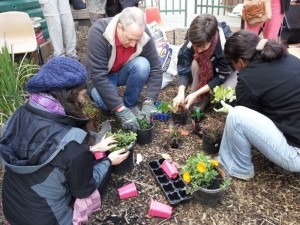
We must also remember that we humans are social creatures, and we maintain psychological and emotional health by interacting with one another in some form of community. Gardening connects you with people and community gardens provide an ideal opportunity for people to interact with each other. Research indicates that local gardening brings about a better sense of community [8] [9] [10].
Gardening for the Spirit
Harvard naturalist and Pulitzer Prize winner Edward O. Wilson, who coined the term biophilia (love of living things) believes that Nature holds the key to health. He believes that we have an affinity for Nature because we are part of it and would prefer to look at flowers and grass rather than concrete or steel. As part of the natural world, we are connected to and restored by it.
A garden can also serve our higher needs, it can provide a harmonious space to relax, unwind, reflect and restore ourselves. It can serve as a place where we can appreciate the beauty, form and colours of Nature.
Gardening reconnects us to natural cycles which are the rhythm of life itself. When we spend time in the garden, we learn to slow down, and when we get absorbed in our activities, we lose sense of all time and space, we forget out daily worries and concern, and we lose ourselves in ‘the zone’, a blissful Zen state where we are totally immersed in our activities and that timeless moment.
According to Clare Cooper Marcus, MA, MCP, professor emerita from the University of California at Berkeley, and one of the founders of the field of environmental psychology, one of the reasons why Nature may be so successful at reducing stress is that it puts the mind in a state similar to meditation. When you engage Nature, you naturally stop thinking, obsessing and worrying. Your senses are awakened, which brings you into the present moment, and this has been shown to be very effective at reducing stress, says Marcus, drawing on her own observations [13].
At the 1999 Culture, Health, and the Arts World Symposium in England beneficial effects of just even looking at nature were reported. In one study, conducted in Uppsala, Sweden, 160 postoperative heart patients were asked to look at a landscape, an abstract art work, or no picture. Those who looked at the landscape had lower anxiety, required less pain medicine, and spent a day less in the hospital than the control group patients [13].
To reap these restorative benefits of Nature, all we need to do is plant a few flowers or herbs and enjoy Nature’s gift to us!
In Conclusion
By creating a space where we can reconnect with Nature, we can provide ourselves the means to heal our mind, body and spirit, and a means heal the planet also. When we grow gardens, we grow life, which we care for, nurture and partake in.
To quote the Permaculturist Geoff Lawton – “All the world's problems can be solved in a garden”
Text and photo credit: Angelo Eliades
References:
Van Den Berg AE, Custers MH.- Gardening promotes neuroendocrine and affective restoration from stress, 2011
Science Daily - Gardening Gives Older Adults Benefits Like Hand Strength And Self Esteem, 2009
American Society for Horticultural Science - Gardening Provides Recommended Physical Activity For Older Adults, 2008
Leon A Simons, et al - Lifestyle factors and risk of dementia: Dubbo Study of the elderly, 2006
European Society of Cardiology - Eating more fruit and vegetables is linked to a lower risk of dying from ischemic heart disease, 2011.
Ulrich RS - View through a window may influence recovery from surgery, 1984
Lowry CA, et al - Identification of an immune-responsive mesolimbocortical serotonergic system: potential role in regulation of emotional behaviour, 2007
Wakefield, S. - Growing urban health: community gardening in South-East Toronto, 2007.
Lombard, KA., et al - Diabetes on the Najavo nation: what role can gardening and agriculture extension play to reduce it, 2006.
Armstrong, D. - A survey of community gardens in upstate New York: implications for health promotion and community development, 2000.
Renate Cervinka, Kathrin Röderer and Elisabeth Hefler - Are nature lovers happy? On various indicators of well-being and connectedness with nature, 2011
Fabrigoule, C. - Social and leisure activities and risk of dementia: a prospective longitudinal study, 1995
WebMD Feature - Gardening for Health, http://www.webmd.com/healthy-aging/features/gardening-health.
A New Life Through Gardening
Part of the pleasure of gardening comes in the sharing of plants, seeds, learning and experience with other gardeners. There are so many stories of people who make gardening their day to day way of life, and their motivation, which very often is the glue that keeps them ‘together’. Our Patron, Jane Edmanson, shares a story of how gardening has contributed to making life sustainable for a vulnerable group of people.
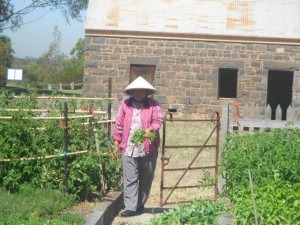
I have had the great pleasure of meeting a group of Karen women, migrants from Burma, who live in the western suburbs of Melbourne, and are now working on a wonderful gardening project at Werribee Park. Many were persecuted by the Burmese military regime and forced to flee to live in refugee camps on the border, some for 22 years. Now they have migrated to Australia, but found life hard due to isolation and lack of English language, many became depressed.
This is where the old kitchen garden at Werribee Park Mansion became important, as a central focus for helping these newly arrived migrants to improved health. James Brincat, Ranger in Charge of Werribee Park, works for Parks Victoria, and is passionate about revitalising this kitchen garden space, and says it has worked a treat. The women come regularly to work on the garden beds, and it is a place they can talk, share experiences and cook a meal together. It was heartening to see the women (and a few men, most are out at work) smiling, chatting and cooking up a storm, and what delicious food they prepared for lunch on the day. All the vegetables and herbs were picked straight from their garden.
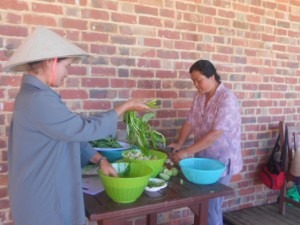 The range is huge: coriander, silverbeet, tomatoes, basil, parsley, chillies, nasturtiums, spring onions, tatsoy, bok choi, lettuces, peas, rhubarb and water spinach. Lots of mustard plants grow as collecting seed is important.
The range is huge: coriander, silverbeet, tomatoes, basil, parsley, chillies, nasturtiums, spring onions, tatsoy, bok choi, lettuces, peas, rhubarb and water spinach. Lots of mustard plants grow as collecting seed is important.
Gardening, harvesting and preparing food has brought people together and it does prove that gardening and sharing really is for everyone.
Story and photo credits: Jane Edmanson
Spring Photo Competition Winners
Congratulations to the three winners of our spring photo competition! A fantastic effort from you and from all the entrants! And thank you to all those who voted on our Facebook page.
In first place is Shane Clifford for a beautiful panorama of his home garden in late spring:
In second place is Tracy Gillard with a busy bee:
And in third place is John Plaxton with a red-cheeked wattle bird on an Echium bloom at breakfast time:
Thank you all for taking the time to capture these moments in nature and sharing them with us.
Powdery Mildew
A warm summer evening, a little bit of moisture, a shady spot in the garden – sounds like a recipe for powdery mildew! Powdery Mildew is a warm weather fungus that will flourish in shady spots with little air circulation and damp conditions. But few simple steps early in the season and a good watering routine will help reduce the risk of this disease attacking your patch or at least lessen the impact if it does.
What Does It Look Like?
Powdery Mildew is a white spotted soft fungus, of which there are numerous varieties. All are powdery in appearance, hence its name. When young, powdery mildew forms as tiny white circles on the leaf, it then reproduces rapidly covering the whole leaf in a white fur. The plant is usually worst affected lower down where it is more humid and sheltered. Mildew will form on the both the upper and undersides sides of leaves and the stem, so the whole plant can become infected. Powdery mildew usually appears in summer and autumn.
Older leaves are covered (especially on the upper surface) with the white powdery fur, young growth that is affected can look a little deformed. Leaves will yellow and die off as the fungus spores enter the leafs surface where the cells remove nutrients.
How does it live and grow?
Powdery mildew loves humid night’s when the temperature is about 15c, especially after a warm day, it just makes the fungus grow and spore. Light breeze’s assists the spores to spread. Particular spots at risk are the dry, warm and shady areas of the garden.
Watering the leaves of a plant in the afternoon increases the humidity at night therefore increasing the likelihood that the spores will spread.
Plants that are particularly susceptible to Powdery Mildew are pumpkin, cucumber, peas, roses, grapes, paw paws, strawberries & apples. There are various types of mildew that can affect different plants, sometimes at the same time. The treatment is pretty much the same for all of them.
Really wet weather, really low (or high) temperatures can reduce the likelihood of your plants suffering from Powdery mildew, though they are things you have no control over. There are some things you can do though to lessen the impact and spread of this furry fungus.
What To Do
- Always water your patch early in the day and ensure the water is delivered at the roots. Watering leaves late on a warm day is an open invitation for powdery mildew to move in.
- Pick up any fallen leaves and dispose of them in the bin, do not compost, most home compost heaps are not sufficiently hot enough to kill off spores.
- Removing the worst affected leaves from the plant may help slow the spread of the disease, plus it will allow for more air circulation.
- When planting out your patch leave plenty of room for each plant, overcrowding means poor air circulation and as we know - powdery mildew thrives where the air circulation is poor.
- Feed your patch with complete balanced organic fertilisers. High nitrogen fertilisers encourage leaf growth and too many leaves leads to – you guessed it – overcrowding and poor air circulation!
- Use a seaweed based plant tonic once a fortnight, it will not only help keep your plant strong, there is anecdotal evidence to suggest that it may help reduce fungal issues too.
- Try a milk spray; (about 1 parts full cream (preferably organic) milk to 10 parts water) and spray it on affected plants. It won’t stop it but it will slow it in it tracks and allow your plant to continue cropping for a few more weeks – always apply any spray treatment in the early morning, otherwise you may be encouraging more fungus.
The black and yellow Fungus Eating Ladybird (Illeis galbula) munches away at the fungus but NOT the leaf beneath! Yes, they’re a gardener’s friend, but definitely not a friend of powdery mildew.
Picture: Elaine Shallue (SGA)
A Queensland Patch
Professor Myles McGregor-Lowndes, Director of The Australian Centre for Philanthropy and Nonprofit Studies at Queensland University of Technology shares his organic patch.
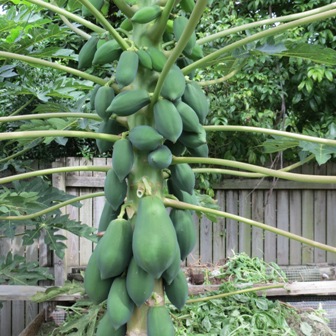
Papaya in fruit, and before the rains came with the inevitable black spot. All one can do is keep the seaweed extract up and remove any diseased leaves as soon as possible. I kept the possums at bay this year by hanging moth balls around the fruit.
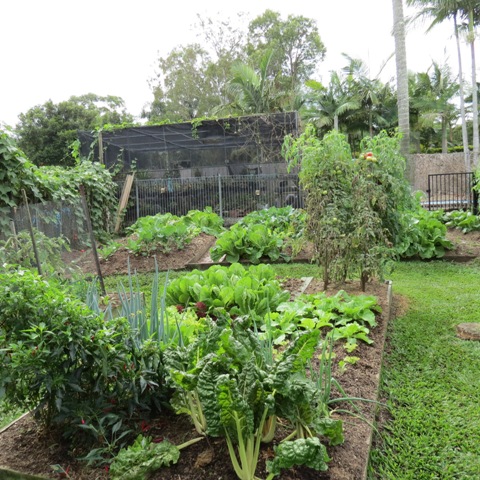
My spring crops include inferno chillies, silverbeet, chokos, chinese cabbage, lettuce, Top Dog tomatoes, spring onions, egg plant and broccoli.
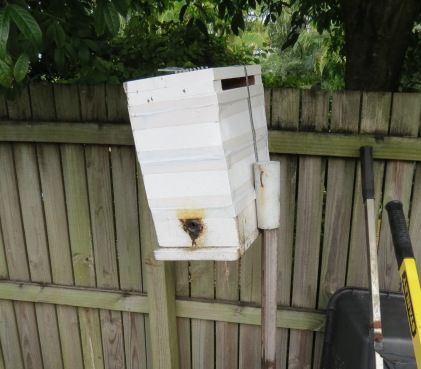
Native bees are just so wonderful to increase pollination rates. There are native bee associations where you can find all the necessary information and tips. They don't sting and so easy to care for once you have the right spot, which in Brisbane is sun until about 10am then light shade.

Douglas the garden dog keeping my newly planted mango safe from any crows which now rarely dare to each my fruit.
If you would like to share your garden check out the submission guidelines and tell us your gardening story.
Weeds: Not in my backyard - Video

Prevent a triffid-style invasion of the worst kinds of weeds. Plants taking over your garden and worse, escaping into our natural areas to create mayhem for native plants and animals. Be alert and be very alarmed, as responsible gardeners do their bit to control the Battle of the Bush.








